
Kathy Tran

Audio By Carbonatix
Dallas’ next culinary revolution began in a quiet specialty grocery store in Irving, a small shop where boxes of imported foods line the metal shelving all the way up to the ceiling. Here, in 2004, a woman named Boonmie Phennara fired up a Bunsen burner to make dinner for visiting friends. They told her she was wasting her kitchen skills running a grocery.
She intended to keep things small. Instead, Nalinh Market’s Bunsen burner sparked a rush of food from Laos that is sweeping across Dallas and Fort Worth. A young generation of Laotian-American restaurateurs, inspired by family traditions and a desire to keep their heritage alive, is determined to make the cuisine an essential part of Dallas’ culinary identity.
Since January 2016, 10 Laotian restaurants, food trucks and farmers market stalls have opened in Dallas-Fort Worth, with an 11th coming soon. The newcomers join a small group of older, more traditional eateries like Nalinh Market. Now, unexpectedly, a nationwide Lao food movement finds many of its leaders in North Texas, a region so rich in sticky rice, laap and papaya salad that it has become the biggest, most exciting Laotian food scene in North America.
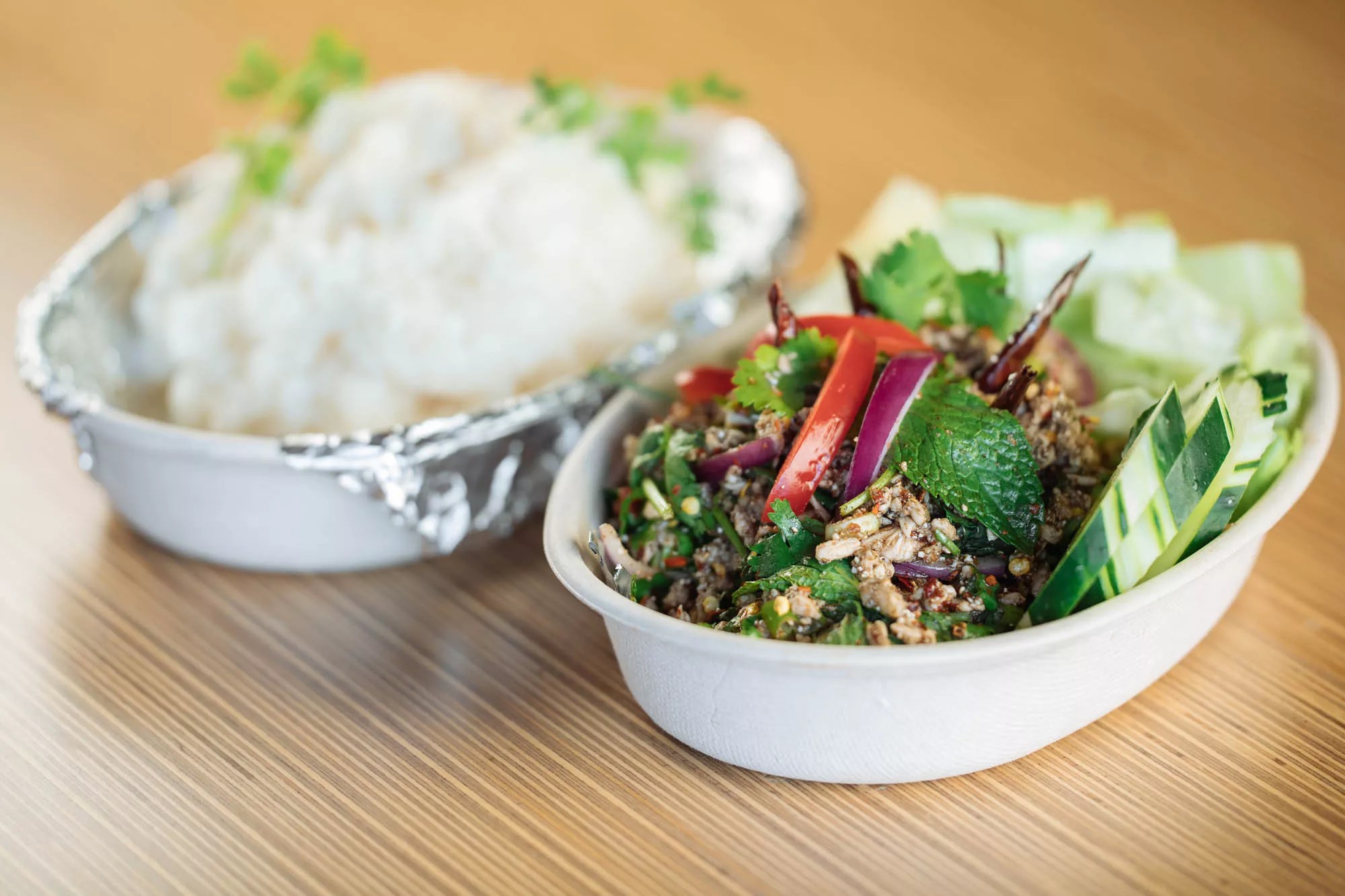
Laab salad at Zaap Kitchen
Kathy Tran
There are good reasons that Laotian food remained hidden from American diners for so long. Laos is a relatively small country — it has just 7 million residents — and its biggest neighbors are inescapable influences in Texas dining: Vietnam, Thailand, China. Those cuisines all show their influences in the food of Laos, too.
The Laotian-American population in metro Dallas sounds small: just 8,000 people. But relative to their home country’s size, that’s a major community, the equivalent of traveling to a city in Asia and discovering that it is home to 32,000 Texans. According to the Pew Research Center, only Sacramento and Minneapolis have more Laotian-Americans than the Dallas-Fort Worth area. A website called Hmong Studies has an even higher tally, ranking the region second nationwide.
For many years, it would have been hard to scan local restaurant listings and detect the second-largest Laotian community in the United States. The causes for that absence are rooted both in Lao culture, where sit-down meals are almost always eaten at home rather than in restaurants, and in American ignorance of Lao cooking. Indeed, many Americans do not even know where Laos is. Its famous neighbors are a different story.
“Unlike Thailand and Vietnam, its neighbors, Laos is rarely represented in American popular culture and presented on the news,” wrote Michelin-starred Laotian-American chef James Syhabout and food writer John Birdsall in their 2018 cookbook, Hawker Fare.
Laos is still subject to one-party communist rule; American warplanes bombed the country in a secret campaign during the Vietnam War. Across the border in Thailand, much of the Isan region’s population is ethnically Lao, and as with Laos, Isan suffers from high poverty. In the past, Thai people have stereotyped Laotians for their relative lack of development.
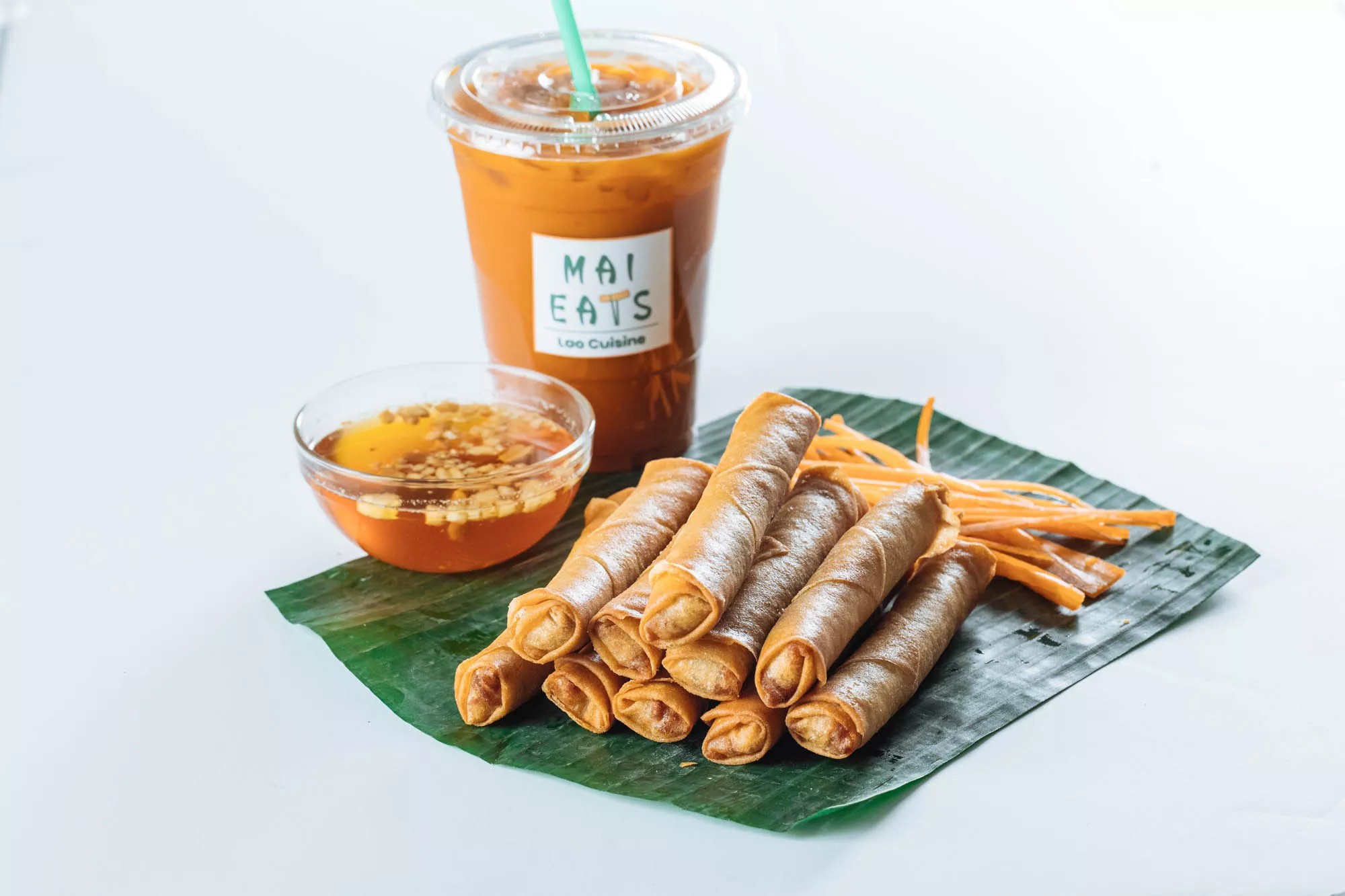
The egg roll appetizer at Mai Eats
Kathy Tran
“I guess it was a big stigma — if you were Lao it was like you were uneducated,” says Anita Dangerfield, owner of the Mai Eats stall at the Dallas Farmers Market. “People were afraid to say they were Lao because they lived in Thailand.”
There are other roadblocks. Laotian food has much in common with Thai and Vietnamese, which makes sense given the countries’ shared borders, but Lao palates tend to favor spicier, sourer, funkier flavors — in other words, flavors scarier to older generations of American diners.
“Lao food is Thai food’s funkier cousin,” says Cliff Douangdara, one of six cousins behind the Dallas-area pop-up series and beef jerky vendor Saap Lao Kitchen. “We use lot of fermented fish sauce that gives a deeper level of umami savoriness.”
As they moved to the United States, a country where they were more or less unknown, Laotian immigrants like Syhabout’s mother worked in Thai restaurants to pay the bills.

From top left to right, clockwise: Khao Poon soup, papaya salad, sticky rice, stir-fry rice, Laab salad, Lao sausage at Zaap Kitchen
Kathy Tran
“Like a quarter of Thai restaurants are owned by Lao chefs,” Douangdara explains. “For the longest time, Lao restaurant owners weren’t really confident enough in their own food to serve it to the American public and disguised their recipes as Thai dishes. The last three or four years, Lao chefs are finally coming out of their shells.”
It’s hard to verify of that one-quarter statistic, but anecdotal evidence suggests Douangdara has a point. Ly Food Market, which serves superb, boldly spiced drunken noodles to Oak Cliff, is owned by a family with roots in Laos. Thai Pakse in Fort Worth is named after a Laotian city. Donny Sirisavath, chef of forthcoming Dallas restaurant Khao Noodle Shop, was raised in the back rooms of a Thai restaurant in San Antonio. His father is Thai Isan, his mother half Lao and half French. Before serving Thai food, they cooked Chinese.
Shadia Abdallah, owner of Fort Worth’s Get Lao’d food truck, adds, “It was hard growing up to show people, my mom is from Laos, let’s go to a Lao restaurant. A lot of them are disguised as Thai restaurants.”
That situation is changing fast. Five new Lao food ventures debuted in Dallas-Fort Worth in 2016; all five are still open, and the trend is accelerating. When Khao Noodle Shop arrives at the corner of Ross Avenue and Bryan Street this June or July, it will mark the region’s fourth new Lao spot in six months. It will also be the second explicitly Lao sit-down restaurant inside Dallas city limits — and the first opened just three months ago.
The founding mother of Laotian cuisine in North Texas isn’t sitting still, either. Phennara, who ignited the revolution at her impromptu cooktop inside Nalinh Market, has a big new professional setup at Sapp Sapp Lao and Thai Kitchen, which opened in 2017 in downtown Irving. It makes the old Bunsen burner look like, well, a Bunsen burner.
Nalinh is still going strong, operating from a kitchen the family was forced to build when curious shoppers began asking Phennara if they could try the food she was serving to her friends.
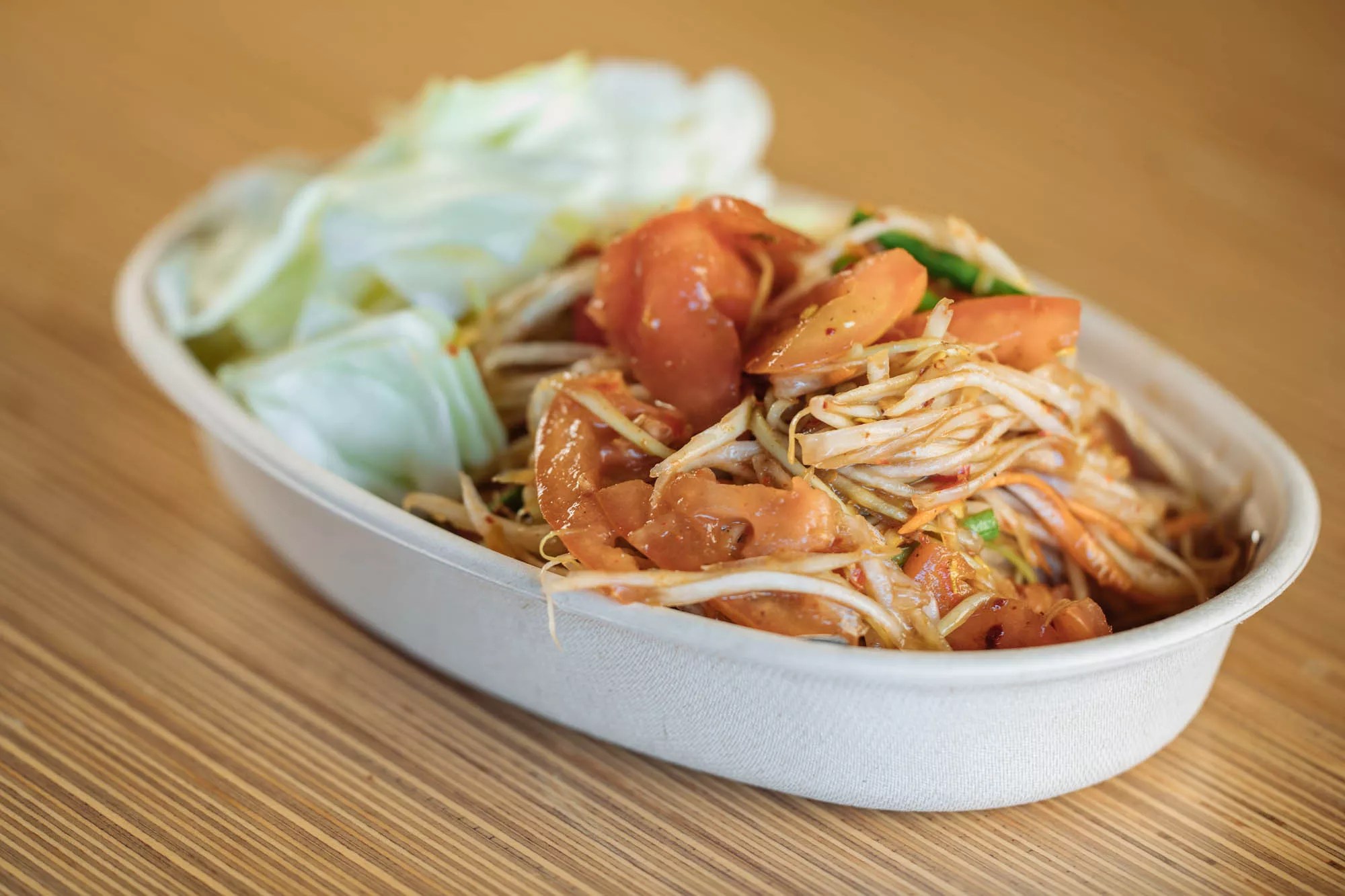
Papaya salad at Zaap Kitchen
Kathy Tran
“We were the first family in the Metroplex to do Lao food,” says Xay Senephoumy, Phennara’s son and the owner of Sapp Sapp. “We weren’t even planning on doing this for a living. She was hooking up friends on a single Bunsen burner, and then she had to go to a double Bunsen burner. And eventually the Bunsen burner wasn’t enough and we had to put in a little kitchen.”
At Sapp Sapp, the emphasis is on the traditional family fare Senephoumy grew up eating. Even dishes like a bowl of pho topped with a cartoonishly huge beef rib are home recipes.
“It’s very rare that people do the old-fashioned simple foods like that,” Senephoumy says. “As kids, we would save the best for last. We would eat the pho and just gnaw on the bone.”
More adventurous dishes include kowpiak Xay-style, a bowl of hearty soup with a savory bone-colored broth and a mixture of crispy-fried pork belly, cubes of solidified pork blood and whole soft-boiled quail eggs. The soup is a riot of textures, the crunchy splinters of pork belly fat jostling with tofu-like squares of blood and a carpeting of fried garlic and fresh green onions.
There is also sookie yaki, not to be confused with Japanese-American sukiyaki. Phennara’s recipe is a seafood soup with glass noodles and meatballs. Moke pah is the Lao answer to the tamale, with fish and spices wrapped in a banana leaf and steamed until the whole thing practically melts. Other Laotian staples round out the menu, including a fiery papaya salad, sides of sticky rice and fatty (but not at all greasy) pork sausages.
Sapp Sapp sells more familiar Thai foods, too, which Senephoumy says is necessary for the business to thrive.
“We have to put the Thai on there because for American culture, Thai is more readily identifiable to them,” he says. “There’s a reason we put the Lao first [in the restaurant’s name], because we are Lao, but without the Thai in there it would be harder to get exposure.”
Another of the city’s Laotian-American family dynasties is trying to make Laos as recognizable to American diners as its neighbor. Boi Singharaj is the restaurateur behind Sabaidee Lao and Thai Street Food on Lemmon Avenue in Dallas and the new Sweet Rice in Frisco; his cousin Tony Singharaj opened Zaap Kitchen on Greenville Avenue in January, and other family members cook at Sticky Rice in Murphy.
The family’s top priority is expanding the audience for Laotian cooking.
“There’s a lot of Lao restaurants here that nobody knows about except Asian people. I don’t want to be like that. I want to say hey, come try the food.” – Boi Singharaj
“There’s a lot of Lao restaurants here that nobody knows about except Asian people,” Boi Singharaj says. “I don’t want to be like that. I want to say hey, come try the food.”
Tony Singharaj, sitting at a table in the sunlit modern dining room at Zaap Kitchen, agrees.
“Growing up, we would bring friends home to birthdays or get-togethers and be like hey, try this food, my mom made it. And that’s the only time that you bring your friends over and they try it. And now we want to take it further. Not just our friends. We want the public.
“It’s kinda sad that it took this long for our generation to introduce our culture.”
The menus at Sabaidee, Zaap and Sweet Rice reflect the cousins’ desire to reach out well past Lao food’s traditional clientele. All three restaurants serve the basics of Laotian cooking to help acclimate newcomers.
“Lao food is a lot of finger food,” Boi Singharaj says. “Sticky rice, Lao sausage, the short rib. Our main dish is the short rib.”
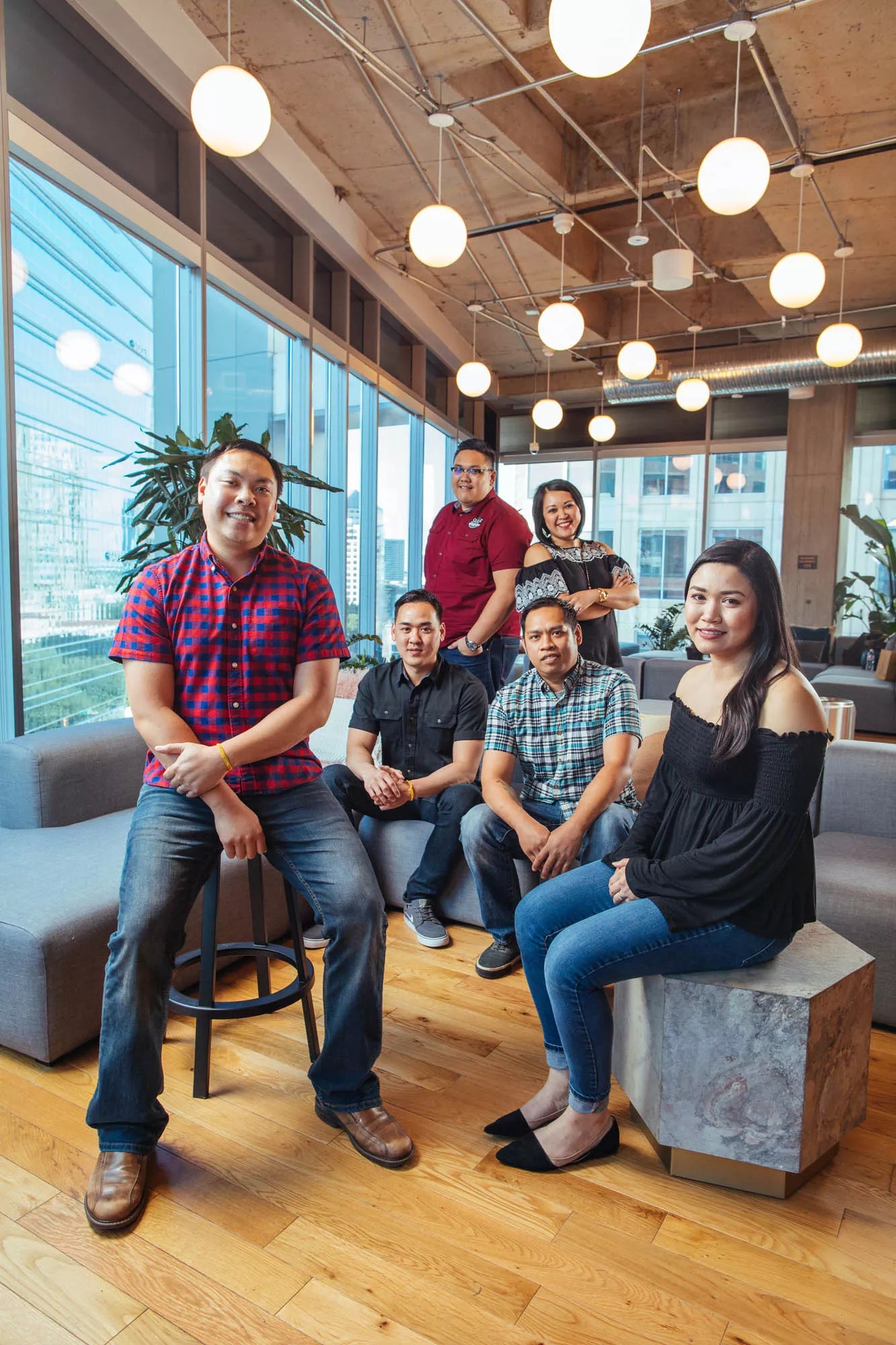
The team at Saap Lao Kitchen (from left to right): Frank Chanthorn, Elson Douangdara (bottom), Cliff Douangdara (top), Kim Chanthorn (top), Frick Chanthorn (bottom), Sandy Sichanh
Kathy Tran
Sabaidee’s diet-busting short ribs are chopped into riblets and deep-fried until the edges are crisp, then sprinkled with a flurry of golden fried garlic. A less finger-friendly hit: Zaap’s khao poon, a comforting, lightly curried chicken noodle soup traditionally served at birthdays and other special occasions.
The combo plate at Zaap is modeled after the most common Laotian meal: meat, papaya salad, sticky rice. These components are meant to be eaten together in one bite: Pinch a clump of sticky rice, use it to scoop up a bit of sweet-spicy papaya salad, add a piece of chicken or beef and maybe dip the whole bite into a tangy lime sauce.
Tony Singharaj offers additional advice for those who’ve never tried papaya salad:
“I always suggest eating the Thai style. The Lao one has a crab paste, crab claw — it’s going to be a bit more bold, stronger taste. Your Thai one’s going to be a bit more sweet, less strong. But the next time they come in, hey, try the Lao one. Some people like it, some people don’t.”
Although each of the family’s restaurants is independently owned, they have similar menus and frequently similar recipes. Zaap was conceived as a sit-down spinoff on the takeout-only Sabaidee. All of them are designed to bring in a new kind of Laotian food fan.
“What I have on my menu, that’s all the basics,” Boi Singharaj says. “Any Lao house party or whatever, any get-together, [our menu] is the must-haves.”
The pop-up series Saap Lao Kitchen is also about introducing the general public to a cuisine it still doesn’t much know. (Sapp Sapp, Zaap Kitchen and Saap are unrelated and have different owners. They get their names from the Lao word for “delicious.”)
Saap began with a New Year’s resolution at a family event, when cousins Cliff and Elson Douangdara; Frick, Loan and Frank Chanthorn; and Sandy Sichanh agreed to go into business together.
“In Christmas of 2015, all of us sat around talking about how there’s not a lot of Laotian food represented in the DFW area. There’s mom-and-pop shops but not a lot of places inviting people to try the food for the first time. We thought we could be that medium,” Cliff Douangdara says.
Frick Chanthorn had experience cooking at The Blind Butcher, but the rest of the family was new to professional food service.
“My brother and all of the cousins grew up in our moms’ kitchens learning the recipes from them,” Cliff Douangdara says. “My mom didn’t have daughters, so most of the food that they made in the kitchen they passed down to us. Most of us are self-taught home cooks. We learned these recipes from our moms and our grandmas.”
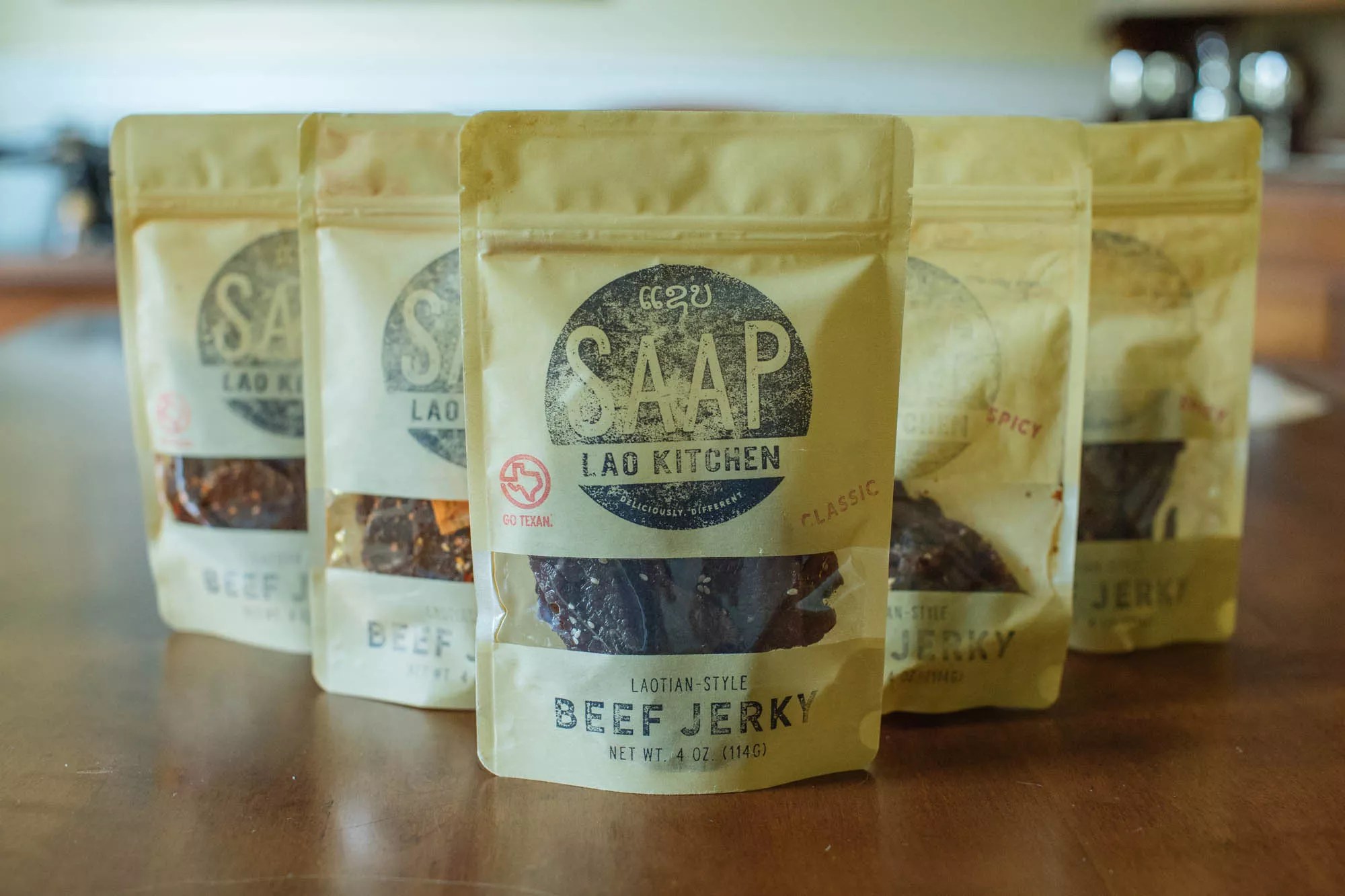
The beef jerky line from Saap Lao Kitchen.
Kathy Tran
Saap operates pop-up events across Dallas, Fort Worth and their suburbs, usually at breweries such as Texas Ale Project, Community and Martin House. But its main business is something the family didn’t expect: beef jerky. The jerky line, which includes regular, “just right” spicy and “too hot for Lao mom” spicy meats, is so successful that making a new batch from scratch each week has become Saap’s primary focus.
Even at pop-up events, jerky plays a starring role. When Saap set up shop at Irving’s Lao New Year festival in early May, the family offered free samples of beef jerky while a grillmaster basted chicken wings and fat Lao sausages over charcoal. Taste the results and it will be clear why the jerky is a hit. The just right spicy version has a first taste of a sweet, sticky glaze that could be applied to barbecued pork ribs. Sesame oil works its flavor into the corner like a shy person in a group photo. Then, suddenly, the heat arrives like a lightning bolt, chile peppers stabbing and lingering long after the meat is chewed and gone.
On the back of the bag is a hand-stamped message: “With every purchase, you support our family’s mission of sharing Laotian food and culture.”
Another popular pop-up business is Get Lao’d, a Fort Worth food truck that serves marinated brisket; barbecue chicken wings with a spicy lime dipping sauce; and nam khao, a dazzling dish that involves frying crispy balls of rice, topping them with cured pork and herbs, and serving the whole thing as a lettuce wrap.
Get Lao’d owner Shadia Abdallah, a half-Laotian, half-Palestinian Fort Worth native, was told as a child that Americans would never like Lao food.
“Growing up, our family’s just trying to hide it. ‘No, no, no, no, keep it in the house.’ No! This is amazing food. We should be sharing it.” – Shadia Abdallah
“Growing up, our family’s just trying to hide it,” she recalls. “‘No no, no, no, keep it in the house.’ No! This is amazing food. We should be sharing it.”
Get Lao’d travels from brewery to brewery, acting as a mobile classroom on how to eat Laotian style. The first two commandments: Eat with your hands, and mix it up with each bite.
“Growing up in a Lao family, you know to grab a piece of the sticky rice, grab some papaya salad, put some meat on top of it and have it all in one bite,” Abdallah explains. “That’s the explosion of flavor. That’s what I try to teach at my food truck because I notice a lot of people don’t try to dig in. It’s finger food.”
She offers more advice:
“With the sticky rice, use your hands. Don’t be afraid. Sticky rice is our tortilla. It’s going to hold everything together. We use sticky rice to hold our meat and our dipping sauces.”
The success of Get Lao’d — which just won Fort Worth magazine’s editor’s choice award for best food truck — has surprised Abdallah, but it’s surprised her skeptics even more.
“The older Lao community are like, hey, you know, American people are not going to like this stuff,” she says. “But probably half the stuff we like today, we wouldn’t have liked 20 years ago. I think everyone’s a lot more open-minded, so it’s the perfect time to just bring it.”
Dallas’ newest Lao pop-up opened in March when Anita Dangerfield, with help from her husband, Marcus, launched Mai Eats at the Dallas Farmers Market. At Mai, which operates on weekends only, the focus is on one core dish: spring rolls.
“Growing up, my parents were always cooking Lao food, and I think one of the fondest memories of my childhood was making spring rolls with my father,” Dangerfield says. “He made them for his coworkers.
“Mai Eats is named after my sister,” she continues. “Growing up, she was always the perfectionist when it came to rolling the perfect rolls. She kind of taught me the secrets, so I named it in her honor. It’s a family recipe. Everybody has their own version, and this is ours. They’re hand-rolled, and we make them weekly.”
At the booth, between servings of spring rolls, dessert tea and fresh-squeezed juices, Dangerfield acts as an informal Laotian ambassador.
“I get it all the time,” she says. “’Oh, where are you from?’ I’m from Laos. ‘Where’s that?’ We’re just not known. I think now [Laotians are] just like OK, this is our food, not to take away from Thai, but a lot of entrepreneurs are trying to promote our culture and cuisine and share it with the world.”
So far, the results are positive. After just six weeks at the farmers market, Dangerfield had to double her spring roll production to meet demand. She plans to add more menu items, too, based on her strengths as a home cook. One possibility: tapioca dumplings, available nowhere else in Dallas and traditionally served only at holidays. The wrapper is made with tapioca flour, and the stuffing includes ground pork, sweet onions and peanuts.
The next Laotian restaurant to open in Dallas will represent a major change from its predecessors. Khao Noodle Shop, planning a summer debut on Ross Avenue just east of Greenville Avenue, will be chef-driven, the region’s first kitchen to put truly modern spins on tradition.
Donny Sirisavath, Khao’s chef, tested his recipes with one of America’s most famous Laotian restaurateurs, Seng Luangrath, owner of trendy Thip Khao in Washington, D.C., and de facto leader of the national Lao food movement. Khao Noodle Shop plans to make all of its noodles in house.
“The older Lao community are like, hey, you know, American people are not going to like this stuff. But probably half the stuff we like today, we wouldn’t have liked 20 years ago. I think everyone’s a lot more open-minded.” – Shadia Abdallah
“My take on it is not the home cook traditional mom-and-pop recipe, even though a lot of recipes are my mom’s,” Sirisavath says. “I’m a chef at heart, and it’s my interpretation of my cuisine, of Mom’s recipe. I wouldn’t say it’s a fusion, it’s just my interpretation.
“Our food is going to be more if you were in Thailand, if you were in Laos. Nothing’s held back. The spiciness, the funkiness, that’s what we want to showcase in our food. We want to transport customers back to Laos or Thailand, as if they’re eating along the streets, enjoying the food, hearing the music as the cars go by.”
Although recipes like Lao tacos with tortillas made from rice flour don’t adhere to tradition, Khao Noodle Shop respects the past in a way that some diners won’t recognize: its location. East Dallas is the area where many of the first Laotian, Cambodian and Vietnamese immigrants lived when they arrived in Texas.
“There’s a reason … we’re not out in the suburbs,” co-owner Tex Sirisawat says. “Our families, when they immigrated here, all their first apartments were all in that area. So that’s where we hang out. That’s our hood.”
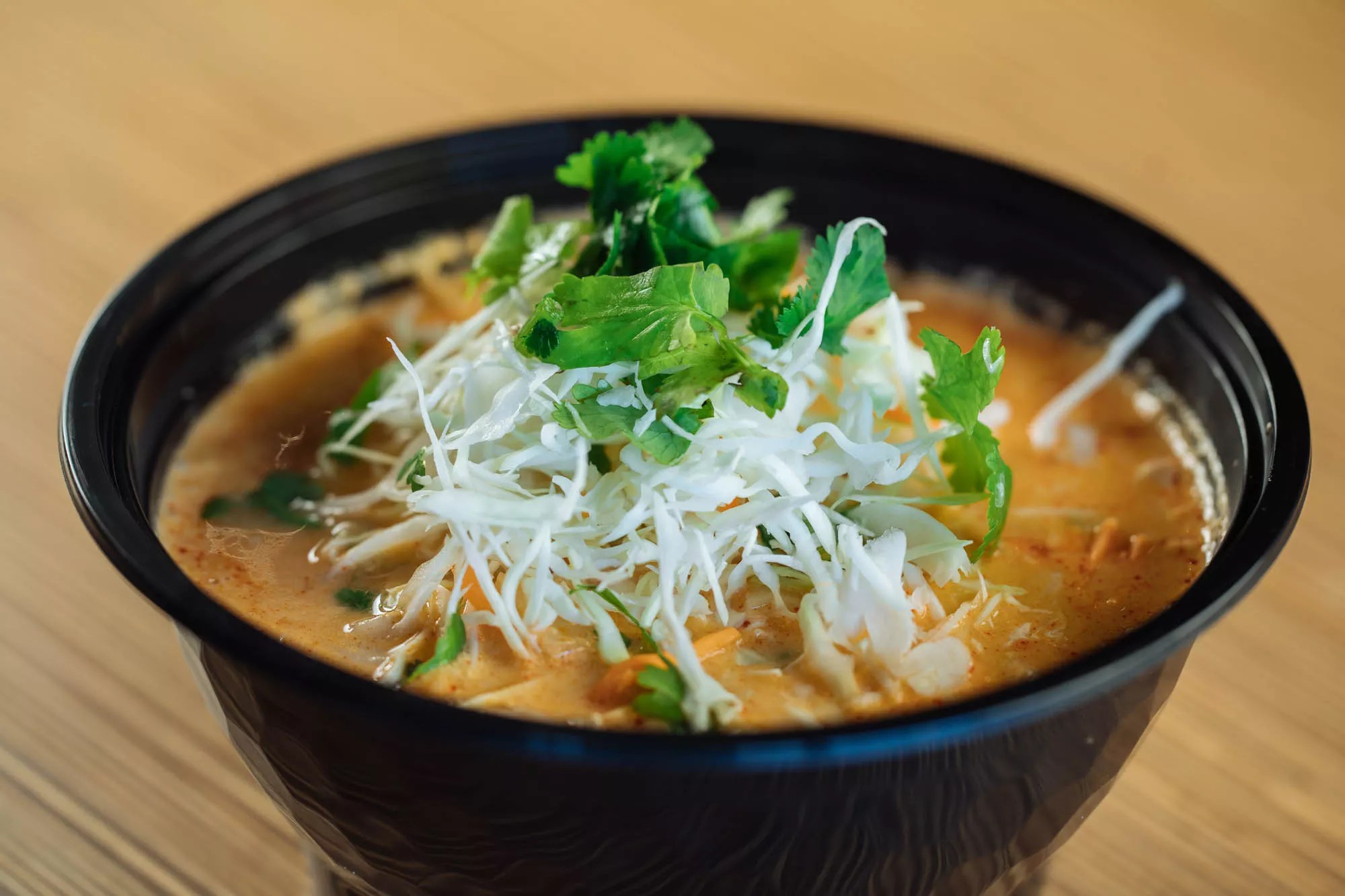
Khao Poon soup at Zaap Kitchen
Kathy Tran
The young entrepreneurs behind Dallas’ Lao food boom don’t seem to understand the national importance of their labors. Dallas and Fort Worth have become, without question, the best cities in America in which to sample Laotian cuisine. Like Irving and Arlington, Sacramento has a lot of mom-and-pop kitchens, many attached to markets or groceries. San Francisco, New York, Washington and Raleigh offer high-end interpretations at restaurants such as Syhabout’s Hawker Fare or Luangrath’s Thip Khao, which have brought the idea of a Lao food movement national recognition.
But those cities have nothing on the scale and youth of Dallas’ movement. Almost every chef in this story is young, and all intend to conquer the city one food truck, farmers market stall or brewery pop-up at a time. North Texas has at least 12 explicitly Laotian restaurants and at least three more Lao businesses that operate as pop-ups. Half of those kitchens, including the forthcoming Khao Noodle Shop, debuted in the last 18 months.
That rapid expansion doesn’t faze the restaurateurs who are driving it. In fact, it seems to energize them.
“Hopefully there will be more Lao restaurants out there,” Boi Singharaj says. “And not just from our family.”
As Cliff Douangdara explains it, “Obviously they’re competitors, right? But I don’t see it that way because there’s kind of a network effect. Because if you get the word out, it grows the pie.”
In other words, as Laotian culture becomes essential to this region’s identity, more non-Asian diners will fall in love with it and there will be more customers for everybody. These entrepreneurs are doing their best to make sure nam khao, moke pah, tapioca dumplings and garlic-dusted pork ribs become nationwide sensations.
The chefs feel determined to make that happen.
“At the very core of it, we just wanted to share our family recipes and elevate Laotian food within the broader American culinary context,” Douangdara says. “We wanted to have as many people experience our family’s food as possible.”
For Abdallah, that motivation is bolstered by a feeling that, hidden behind America’s Thai restaurants, Laotian traditions were becoming endangered.
“I just had a huge passion for cooking Lao food,” she says. “I just saw it slowly dying, and I thought, we can’t let this die out. I think that’s how all the younger generation feel. We can’t let this die. We have to keep it going.”